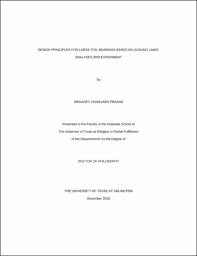
ATTENTION: The works hosted here are being migrated to a new repository that will consolidate resources, improve discoverability, and better show UTA's research impact on the global community. We will update authors as the migration progresses. Please see MavMatrix for more information.
Show simple item record
| dc.contributor.advisor | Kim, Daejong | |
| dc.creator | Honavara Prasad, Srikanth | |
| dc.date.accessioned | 2020-01-14T22:17:45Z | |
| dc.date.available | 2020-01-14T22:17:45Z | |
| dc.date.created | 2018-12 | |
| dc.date.issued | 2018-12-06 | |
| dc.date.submitted | December 2018 | |
| dc.identifier.uri | http://hdl.handle.net/10106/28889 | |
| dc.description.abstract | Gas foil bearings are used for supporting high speed turbomachinery systems. They are characterized by complex physical and thermal interactions between the lubricating fluid and the structural elements. Mathematically, the behavior of such systems is governed by nonlinear partial differential equations and pose substantial computational challenges. However, their potential applications in aerospace systems and power generation systems have renewed research and development efforts aimed at simplifying their design and analyses methods. Commercialization of gas foil bearings in Mega Watt scale applications necessitate the development of simple tools for estimating bearing design parameters such as load capacity, radial clearance, and support structure stiffness, etc.
NASA engineers developed the “rule of thumb” guidelines for estimating foil bearing load capacity based on the bearing projected area, operating speed, and design considerations. The load capacity relation was based on experimental data available at that time (2000). Other researchers used the “rule of thumb” to develop scaling laws for estimating foil bearing design parameters such as radial clearance and support structure stiffness. However, the usefulness of scaling laws in the design of large foil bearings had not been demonstrated previously.
In this dissertation, a four degree of freedom (4-DOF) rotordynamic analysis performed for typical double overhang turbomachinery systems employing foil bearings designed following the scaling laws is presented. Further, case studies to show the feasibility of foil bearings for applications in Mega Watt range turbo blowers and turbo compressors is also presented. In addition, a full-scale experimental test rig for a 200 mm hybrid air foil bearing is designed and constructed for verifying the application of scaling laws in bearing design. The results of preliminary tests characterizing zero speed stiffness characteristics are presented. | |
| dc.format.mimetype | application/pdf | |
| dc.language.iso | en_US | |
| dc.subject | Gas foil bearings | |
| dc.subject | Hybrid air foil bearings | |
| dc.subject | Large foil bearings | |
| dc.subject | 200 mm hybrid air foil bearings | |
| dc.title | Design principles for large foil bearings based on scaling laws: Analyses and Experiment | |
| dc.type | Thesis | |
| dc.degree.department | Mechanical and Aerospace Engineering | |
| dc.degree.name | Doctor of Philosophy in Aerospace Engineering | |
| dc.date.updated | 2020-01-14T22:19:55Z | |
| thesis.degree.department | Mechanical and Aerospace Engineering | |
| thesis.degree.grantor | The University of Texas at Arlington | |
| thesis.degree.level | Doctoral | |
| thesis.degree.name | Doctor of Philosophy in Aerospace Engineering | |
| dc.type.material | text | |
Files in this item
- Name:
- HONAVARAPRASAD-DISSERTATION-20 ...
- Size:
- 7.512Mb
- Format:
- PDF
This item appears in the following Collection(s)
Show simple item record


